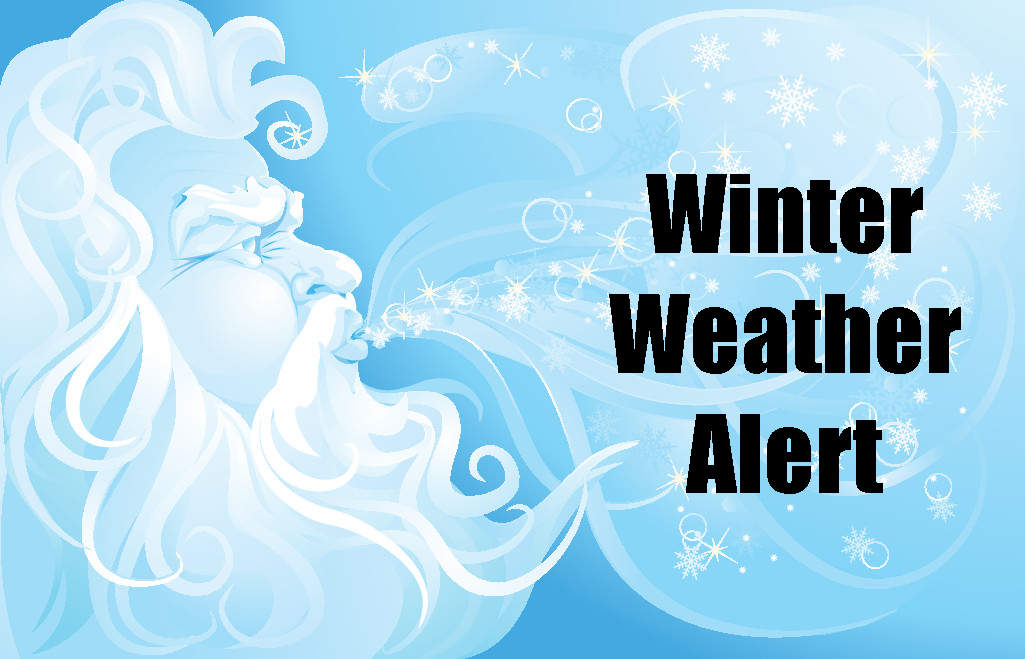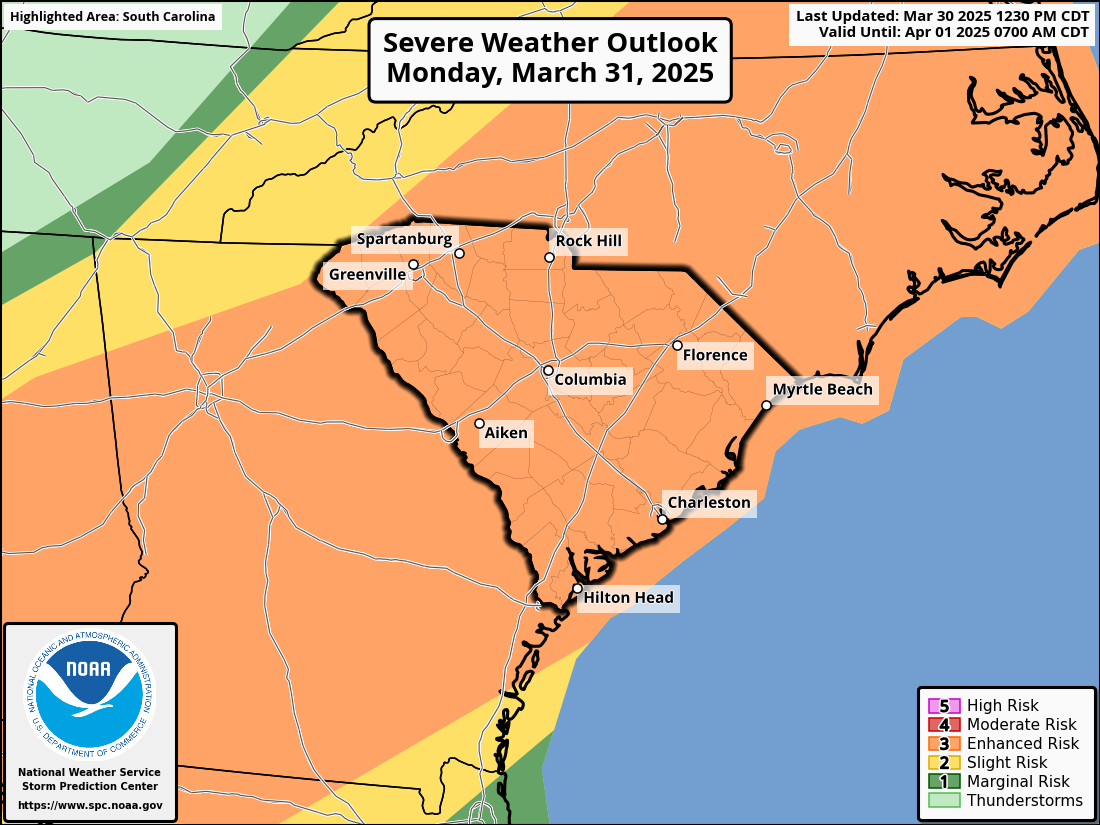By Frank Strait
Severe Weather Liaison
S.C. State Climate Office
S.C. Department of Natural Resources
Key Points:
-Frigid air, perhaps the coldest of the winter, will arrive by Sunday night.
-The frigid air will linger through midweek at least.
-We’re at risk of seeing a winter storm at the middle to end of next week; however, there remains considerable uncertainty about the level of impact due to the usual uncertainty about storm track, intensity, and timing.
-There is a chance for a major winter storm, with effects lingering well after the storm ends due to slow melting. However, it is still too early to talk about specific amounts of snow and ice.
We have a lot of weather talk and worry about over the next week. Next week looks frigid, and we may need to do some proverbial hatch-battening at midweek ahead of a winter storm.
Let’s take care of first things first, though. We begin with tranquility and an area of seasonably chilly high-pressure overhead. That is drifting away to the east, and today is likely to be the only nice-by-January-standards day of the next week or more. We remain quiet through tonight, and it won’t get too cold as clouds start to stream in.
A cold front over the upper Midwest and northern Plains states will approach Saturday. Ahead of it, a disturbance now over the Southwest will track along the southern tier of states. It will have some moisture to work with, so look for some showery rain to break out during the midday and afternoon. Some of y’all along the Coastal Plain may hear a rumble two of thunder, but it will be lukewarm there at best, with highs 55-60, so there will be no severe storm risk. Highs will mainly be 50-55 elsewhere in South Carolina.
The cold front will push through Saturday night into Sunday. A storm will form along the front as it moves through, but it will be in its formative stage while crossing South Carolina. So, it will just bring showers on Sunday, mainly through the morning. If you’re traveling north or west, the storm’s effects will be much more significant, as areas from Tennessee to Maine will see snow from this storm. This developing storm will make it blustery, with South Carolina (and its vicinity, with stronger winds in the mountains) seeing gusts above 30 mph, an annoyance for motorists and pickleball players alike. I expect my Sunday afternoon pickleball session to be even more of a comedy of errors than usual.
Behind this front, we will receive a major blast of arctic air, the coldest we have seen this season. Temperatures likely fall from midday highs. Moisture moves out before this cold air moves in, but maybe a few of western North Carolina’s northwest flow-generated snowflakes sneak over the mountains into the Upstate.
Temperatures will plunge Sunday night, and we’ll be in the teens across the Upstate with 20s elsewhere in the state Monday morning.
Despite sunshine, temperatures will only recover to the 30s and low 40s on Monday.
We’ve reached the end of the part of the forecast where there is good confidence about what will happen. The forecast for Tuesday and beyond is very uncertain because the weather pattern is complicated, and the weather systems that will affect us are over the North Pacific and the Arctic region.

Image Source: University of Wisconsin RealEarth
The storm that likely will affect us is over the Gulf of Alaska today, and it’s part of a complicated setup over there, with several smaller storms rotating around a monster storm near the Bering Strait like spokes on a bicycle wheel. It’s also in an area where weather observations are sparse, so we’re not feeding good data about the storm into the computer models we rely on. Also, disturbances (off the map above) will be diving south across Canada and the central U. S. that may join forces with the storm next week.
A pattern this complex is one that computer models will struggle with, and having the features we care about over areas where we don’t have good observations makes the situation even worse. So, we won’t have a good handle on what will happen around midweek until Sunday or Monday when the features that matter are in areas with good weather observations.
Currently, the computer models are all over the place and inconsistent run-to-run. They give us ideas ranging from two smaller storms moving through next week with minor or perhaps no impacts to a historic winter storm. Neither of those extremes is likely to be correct. So, we must be very general about what could happen and cover a few possibilities.
The most likely scenario is for the Gulf of Alaska disturbance to meet up with a storm coming through Canada over the western states and then push across the southern tier of states. In this scenario, the usual questions about storm track, intensity, and timing apply, along with how much warmth aloft the storm will bring with it. However, the result here would be a significant winter storm for a large part of the state, perhaps statewide. Right now, I think the inland Coastal Plain and I-20 Corridor has the best chance to see heavy snow (I’ll define that as four inches or more). Snow and ice would hang around after the storm because melting would be slow.
The second possibility involves less interaction between the two weather features, resulting in more of a longer, drawn-out event or a 1-2 punch. The result would be a lesser impact overall, and maybe one of the two separate storms is a near miss. Snow and ice would be enough to cause impacts over some or all of South Carolina, but they would be less severe and probably only linger for a day or two.
So, to translate all that into an actual forecast, Tuesday looks bitterly cold with increasing cloudiness. It would get no higher than the 30s, maybe staying below freezing in the Upstate. Then, late Tuesday through Wednesday night or Thursday morning brings us a chance for a winter storm. It might be a heavier event that runs only 12-18 hours or one or two lesser events spread over most of the period. Once again, it gets no higher than the 30s on Wednesday, and much of the state could stay below freezing. We then see improving weather on Thursday, but it will remain cold: 30s for most of the state if we have snow cover and perhaps the high 30s to mid-40s if there isn’t much snow to reflect sunlight into space.
Questions abound for next Friday and next weekend. The above is plenty to digest, but we have the risk of another winter weather event, probably minor, at the end of next week as fresh cold air arrives from the northwest.
If you’re tired of the cold, we will probably shift to a warmer weather pattern the following week.
This weekend and Monday will be your time to prepare. First, it will be frigid Monday and Tuesday, with lows in the teens and 20s. Some spots northwest of I-85 might drop to the single digits. If you haven’t winterized yet and have just been lucky, you’ll take an even bigger chance this weekend, with daytime temperatures only briefly above freezing. Then, there’s the winter storm risk after that. There’s a chance it’s a doozy where you are. If not, you still likely see at least minor effects. So ensure you have what you need if you cannot get around for a couple of days: “milk sandwich” supplies and anything else you need or want. You can find more information on winter storm prep in SCEMD’s Severe Winter Weather Guide.







